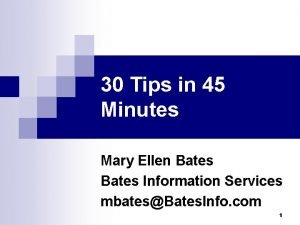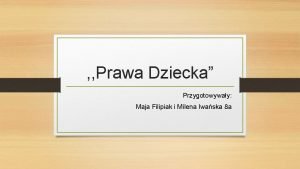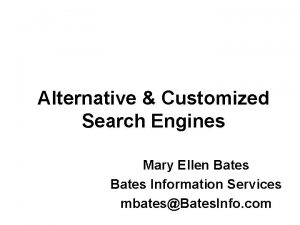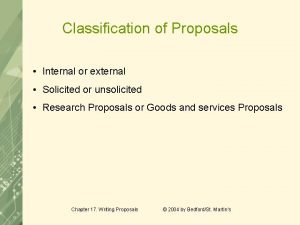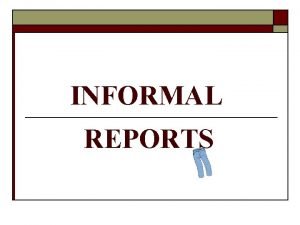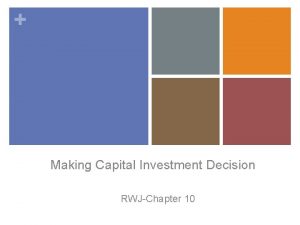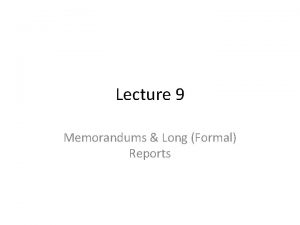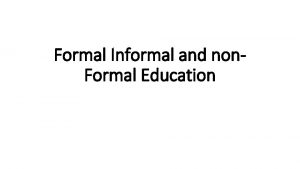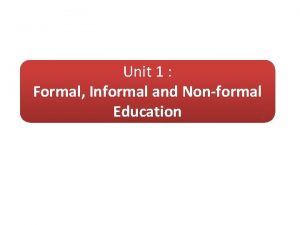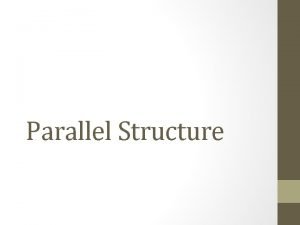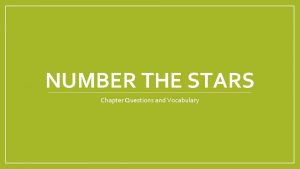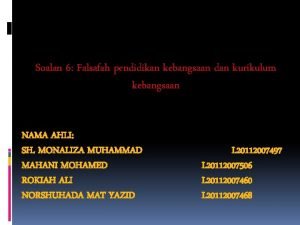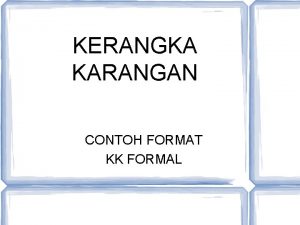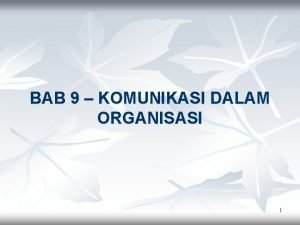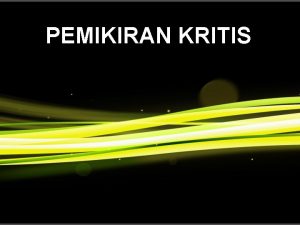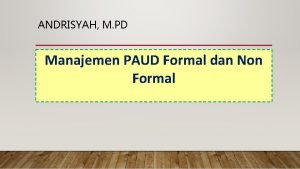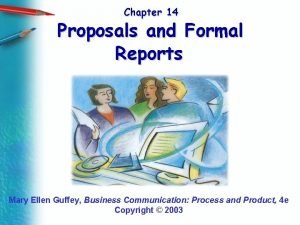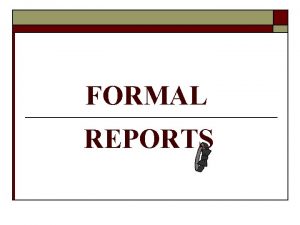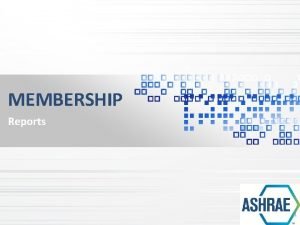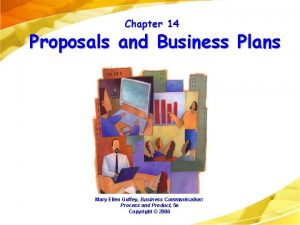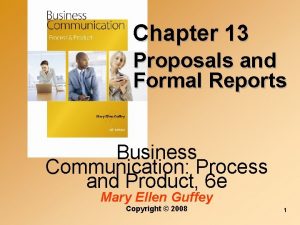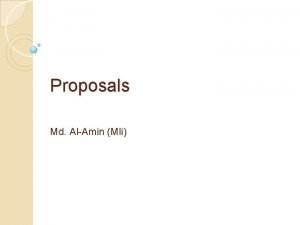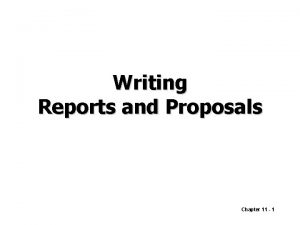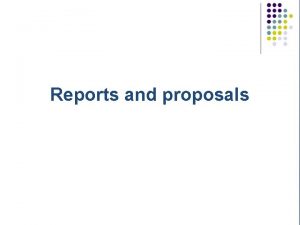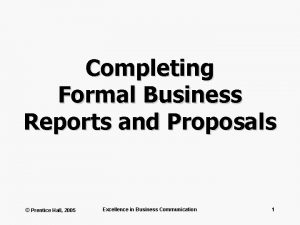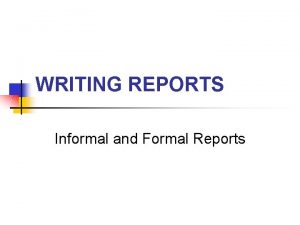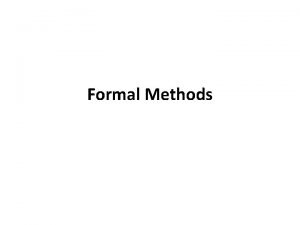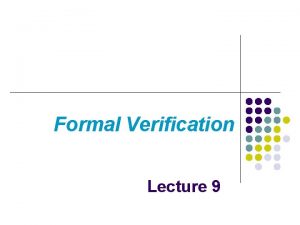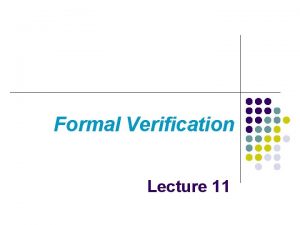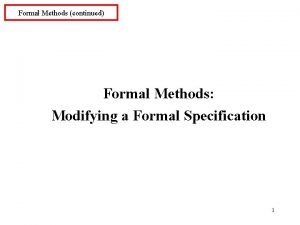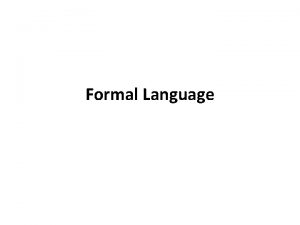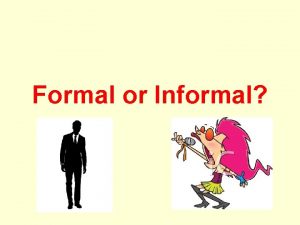Chapter 14 Proposals and Formal Reports Mary Ellen







































- Slides: 39

Chapter 14 Proposals and Formal Reports Mary Ellen Guffey, Business Communication: Process and Product, 5 e Copyright © 2006

Writing Proposals Mary Ellen Guffey, Business Communication: Process and Product, 5 e 2

Writing Proposals • Proposals are written offers to solve problems, provide services, or sell equipment. • An RFP is a request for proposal. Mary Ellen Guffey, Business Communication: Process and Product, 5 e 3

Writing Proposals • Introduction • Explain why the proposal is being made. • Develop a persuasive “hook. ” Suggest excellent results, low cost, or exclusive resources. Identify a problem or name a key issue or benefit. Mary Ellen Guffey, Business Communication: Process and Product, 5 e 4

Writing Proposals • Background, Problem • Discuss the significance of the proposal and its goals or purposes. • For unsolicited proposals, convince the reader that a problem exists. • For solicited proposals, show that you fully understand the problem and its ramifications. Mary Ellen Guffey, Business Communication: Process and Product, 5 e 5

Writing Proposals • Proposal, Plan • Present your plan for solving the problem. • Describe implementation and evaluation. • Outline a schedule showing dates. Mary Ellen Guffey, Business Communication: Process and Product, 5 e 6

Writing Proposals • Staffing • Explain the specific credentials and expertise of the key personnel for the project. • Show that your support staff and resources are superior to those of the competition. Mary Ellen Guffey, Business Communication: Process and Product, 5 e 7

Writing Proposals • Budget • Itemize costs carefully. Proposals are contracts. • Present a deadline for the bid figures. Mary Ellen Guffey, Business Communication: Process and Product, 5 e 8

Writing Proposals • Authorization • Ask for approval. Make it easy to reply. Mary Ellen Guffey, Business Communication: Process and Product, 5 e 9

Components in Formal and Informal Proposals • • • • Copy of RFP Generally appearing in formal proposals Letter of transmittal Abstract or summary Title page Table of contents List of figures Introduction Background, problem, etc. Schedule Staffing Budget Authorization Appendix Mary Ellen Guffey, Business Communication: Process and Product, 5 e 10

Components in Formal and Informal Proposals • • • • Copy of RFP Generally optional in informal proposals Letter of transmittal Abstract or summary Generally appearing in informal proposals Title page Table of contents List of figures Introduction Background, problem, etc. Schedule Staffing Budget Authorization Appendix Mary Ellen Guffey, Business Communication: Process and Product, 5 e 11

Creating Business Plans A business plan is a form of proposal that (a) Helps secure funding and (b) Provides a detailed road map for a new business to follow Mary Ellen Guffey, Business Communication: Process and Product, 5 e 12

Components in Typical Business Plans • Letter of transmittal and/or executive summary • Table of contents • Company description • Product/service description • Market analysis • Operations and management • Financial analysis • Appendixes Mary Ellen Guffey, Business Communication: Process and Product, 5 e 13

Business Plan Basics: Questions to Ask • • • What is you company’s mission? What makes your concept better than that of the competition? Is your management team able to implement the business plan? What monetary, human, physical, and technical resources do you need? Do your financial projections make sense? Mary Ellen Guffey, Business Communication: Process and Product, 5 e 14

Preparing Formal Reports Mary Ellen Guffey, Business Communication: Process and Product, 5 e 15

Preparing Formal Reports • Analyze the report problem and purpose • Develop a problem question Are customers satisfied with our service? • Develop a purpose statement The purpose of this report is to investigate customer satisfaction and to recommend areas for improvement. Mary Ellen Guffey, Business Communication: Process and Product, 5 e 16

Preparing Formal Reports • Anticipate the audience and the issues • Consider primary and secondary audiences. (What do they already know? What do they need to know? ) • Divide the major problem into subproblems for investigation. Mary Ellen Guffey, Business Communication: Process and Product, 5 e 17

Preparing Formal Reports • Prepare a work plan • Include problem and purpose statements. • Describe sources and methods of collecting data. • Prepare a project outline and work schedule. Mary Ellen Guffey, Business Communication: Process and Product, 5 e 18

Preparing Formal Reports • Collect data • Search secondary sources. • Gather primary data. Mary Ellen Guffey, Business Communication: Process and Product, 5 e 19

Preparing Formal Reports • Document data sources • Prepare note cards or separate sheets citing all references (author, date, source, page, and quotation). • Use one documentation format consistently. Mary Ellen Guffey, Business Communication: Process and Product, 5 e 20

Preparing Formal Reports • Interpret and organize the data • Arrange the collected data in tables, grids, or outlines that help you visualize relationships and interpret meanings. Mary Ellen Guffey, Business Communication: Process and Product, 5 e 21

Preparing Formal Reports • Prepare the graphics • Make tables, charts, graphs, and illustrations – but only if they serve a function. Use graphics to clarify, condense, simplify, or emphasize your data. Mary Ellen Guffey, Business Communication: Process and Product, 5 e 22

Preparing Formal Reports • Compose the first draft • Write the first draft at a computer. Use appropriate headings as well as transitional expressions to guide the reader. Mary Ellen Guffey, Business Communication: Process and Product, 5 e 23

Preparing Formal Reports • Revise and proofread • Revise to eliminate wordiness, ambiguity, and redundancy. • Look for ways to improve readability, such as using bulleted or numbered lists. • Proofread three times: (1) word or sentence meaning, (2) grammar and mechanics, and (3) formatting. Mary Ellen Guffey, Business Communication: Process and Product, 5 e 24

Preparing Formal Reports • Evaluate the product • Ask yourself, “Will this report achieve its purpose”? • Encourage feedback so that you can improve future reports. Mary Ellen Guffey, Business Communication: Process and Product, 5 e 25

Formal Report Components Mary Ellen Guffey, Business Communication: Process and Product, 5 e 26

Formal Report Components • Title page • Balance the following lines: • • Name of the report in all caps Receiver’s name, title, and organization Author’s name, title, and organization Date submitted Mary Ellen Guffey, Business Communication: Process and Product, 5 e 27

Formal Report Components • Letter or memo of transmittal • Announce the topic and explain who authorized it. • Briefly describe the project and preview the conclusions – if the reader is supportive. • Close by expressing appreciation for the assignment, suggesting follow-up actions, acknowledging the help of others, and offering to answer questions. Mary Ellen Guffey, Business Communication: Process and Product, 5 e 28

Formal Report Components • Table of contents • Show the beginning page number where each report heading appears in the report. • Connect page numbers and headings with dots. Mary Ellen Guffey, Business Communication: Process and Product, 5 e 29

Formal Report Components • List of illustrations • Include a list of tables, illustrations, or figures. • Place the list on the same page as the table of contents if possible. Mary Ellen Guffey, Business Communication: Process and Product, 5 e 30

Formal Report Components • Executive summary or abstract • Summarize the report purpose, findings, conclusions, and recommendations. • Gauge the length of the summary by the length of the report and by the organization’s practices. Mary Ellen Guffey, Business Communication: Process and Product, 5 e 31

Formal Report Components • Introduction • Explain the problem motivating the report. • Describe the problem’s background and significance. • Clarify the scope and limitations of the report. • Consider reviewing relevant literature. • Consider describing data sources, methods, and key terms. • Close by previewing the report’s organization. Mary Ellen Guffey, Business Communication: Process and Product, 5 e 32

Formal Report Components • Body • Discuss, analyze, and interpret the research findings or proposed solution to the problem. • Arrange the findings in logical segments that follow your outline. • Use clear, descriptive headings. Mary Ellen Guffey, Business Communication: Process and Product, 5 e 33

Formal Report Components • Conclusions and recommendations • Explain what the findings mean in relation to the problem. • Make enumerated recommendations, if requested. • Suggest actions for solving the problem. Mary Ellen Guffey, Business Communication: Process and Product, 5 e 34

Formal Report Components • Appendix • Include items of interest to some, but not all, readers, such as data-gathering tools like questionnaires. Mary Ellen Guffey, Business Communication: Process and Product, 5 e 35

Formal Report Components • References and bibliography • If footnotes are not provided, list all references in a section called “Notes, ” “Works Cited, ” or “References. ” • Optionally, include a bibliography showing all the works cited (and perhaps consulted) arranged alphabetically. Mary Ellen Guffey, Business Communication: Process and Product, 5 e 36

Components in Formal and Informal Reports • • • • Cover Title page Letter of transmittal Table of contents List of figures Executive summary or abstract Introduction Body Conclusions Recommendations Appendix Notes Bibliography Generally appearing in formal reports Mary Ellen Guffey, Business Communication: Process and Product, 5 e 37

Components in Formal and Informal Reports • • • • Cover Title page Letter of transmittal Table of contents List of figures Executive summary or abstract Introduction Body Conclusions Recommendations Appendix Notes Bibliography Generally optional in informal reports Generally appearing in informal reports Mary Ellen Guffey, Business Communication: Process and Product, 5 e 38

End Mary Ellen Guffey, Business Communication: Process and Product, 5 e 39
 A business proposal chapter 10
A business proposal chapter 10 Writing and completing reports and proposals
Writing and completing reports and proposals Reports and proposals
Reports and proposals How do informational reports and analytical reports differ
How do informational reports and analytical reports differ Mary ellen mark
Mary ellen mark Mary ellen bates
Mary ellen bates Maja filipiak
Maja filipiak Mary ellen ledbetter
Mary ellen ledbetter Mary ellen bates
Mary ellen bates Title of the study
Title of the study What are the two categories of external proposals
What are the two categories of external proposals Informal business report example
Informal business report example Artificial intelligence thesis proposals
Artificial intelligence thesis proposals Functions of fire insurance
Functions of fire insurance When evaluating cost-cutting proposals
When evaluating cost-cutting proposals Developing effective research proposals
Developing effective research proposals Eclipse computing proposals slow
Eclipse computing proposals slow Delhi muslim proposals
Delhi muslim proposals Long formal report
Long formal report Analytical reports are always formal
Analytical reports are always formal Mary wollstonecraft mary a fiction
Mary wollstonecraft mary a fiction Non formal education examples
Non formal education examples Unit 1 formal informal and non formal education
Unit 1 formal informal and non formal education Is als a non formal education
Is als a non formal education Ellen white tithe
Ellen white tithe Ellen likes hiking, the rodeo, and to take afternoon naps.
Ellen likes hiking, the rodeo, and to take afternoon naps. Number the stars vocabulary and questions
Number the stars vocabulary and questions Maintenance of records and reports in obg
Maintenance of records and reports in obg Explain input and output form design
Explain input and output form design Ejemplo de inculto informal
Ejemplo de inculto informal Kurikulum kebangsaan
Kurikulum kebangsaan Contoh kerangka karangan formal
Contoh kerangka karangan formal Contoh komunikasi mendatar
Contoh komunikasi mendatar Falasi informal
Falasi informal Keperluan esteem
Keperluan esteem Aap1 educação formal e não formal
Aap1 educação formal e não formal Fungsi manajemen paud
Fungsi manajemen paud Robin of locksley
Robin of locksley Quem foi ellen white
Quem foi ellen white Ellen goldring
Ellen goldring





